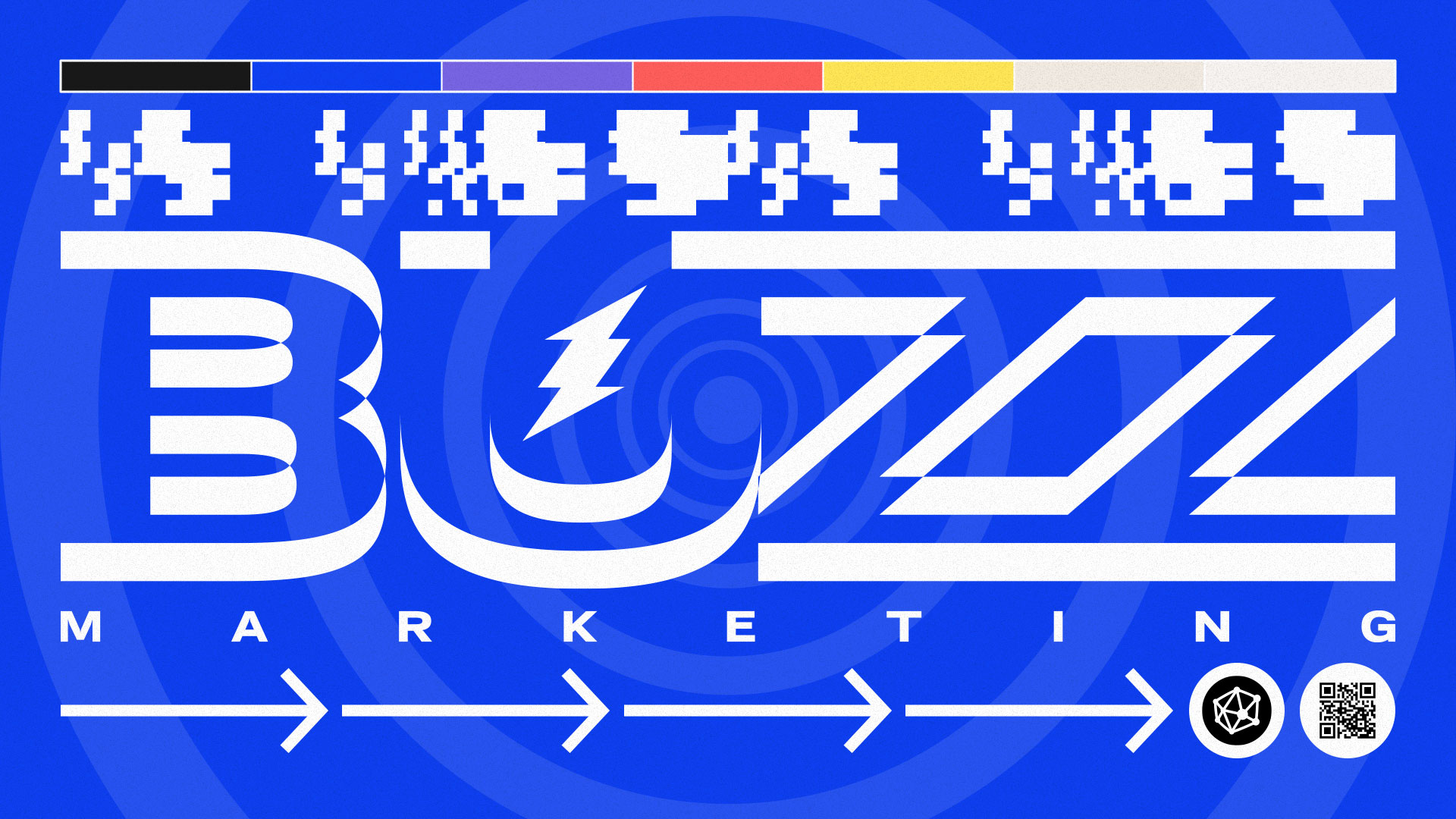It’s always nice to have people talking about your product or brand, and a buzz marketing campaign can make sure that happens.
Creating a buzz is a powerful way to get the word out about your upcoming launch or make sure people are aware of how great your product is.
Not quite sure how to make that happen?
We’ve put together this guide to help you understand:
- What buzz marketing is
- Why you need to harness buzz marketing
- The different ways you can implement buzz marketing plus some tips
Along with some real-world examples to give you some inspiration.
Table of Contents
What is Buzz Marketing? A Simple Definition for Beginners
What are the Benefits of Buzz Marketing?
What are the Types of Buzz Marketing?
5 Examples of Buzz Marketing to Inspire You
3 Buzz Marketing Tips You Need to Know
How to Create a Buzz Marketing Campaign
What is Buzz Marketing?
Buzz marketing aims to generate conversations, hype, and online chatter about your brand or product.
When done right, you should see people talking about your company in online and offline conversations.
The main focus of buzz marketing is to get your brand out there through word of mouth – that is, your message getting passed along by your audience as well as from you directly.
Marketers use a range of techniques in the hopes of getting people to chat on social media, the internet, and in their offices and friend circles.
What is the connection between buzz and viral marketing?
Buzz marketing is a type of viral marketing that tries to get people talking about a marketing campaign.
Viral marketing in general aims to get a piece of content, like an Instagram post or YouTube video, shared many times across the internet.
Buzz marketing goes deeper and aims to initiate conversations, blog posts, and some fear of missing out (FOMO).
If you’re able to make a post go viral on social media, you have a very good chance that it’ll create a buzz and generate attention in your local area or in your industry.
What is the difference between influencer marketing and buzz marketing?
The difference between buzz marketing and influencer marketing is the aim; buzz marketing is about reaching as big an audience as possible while influencer marketing tends to ask a person’s followers to complete a certain action, usually buying a product.
Using influencers can be one of the marketing tactics in a successful buzz marketing campaign.
By asking them to engage with their audience and spread your message, you can work on getting some buzz going.
What is the negative buzz in buzz marketing?
Negative buzz is when the chat about your brand or messaging becomes negative, such as when an influencer you work with turns out to be fake or there’s a big problem with your product.
Your brand reputation can take a hit when the buzz about it becomes negative.
It’s possible to manage negative buzz by finding the source, taking clear steps to resolve issues, and being honest about the situation.
What are the Benefits of Buzz Marketing?
Done right, a successful buzz marketing campaign can be a really positive way to get your marketing message across, particularly for a startup or small business.
You’re able to:
- Build anticipation for a product launch
- Increase customer engagement as people become curious about your brand
- Boost your reach on social networks and beyond
Why choose a buzz marketing campaign rather than other types of marketing?
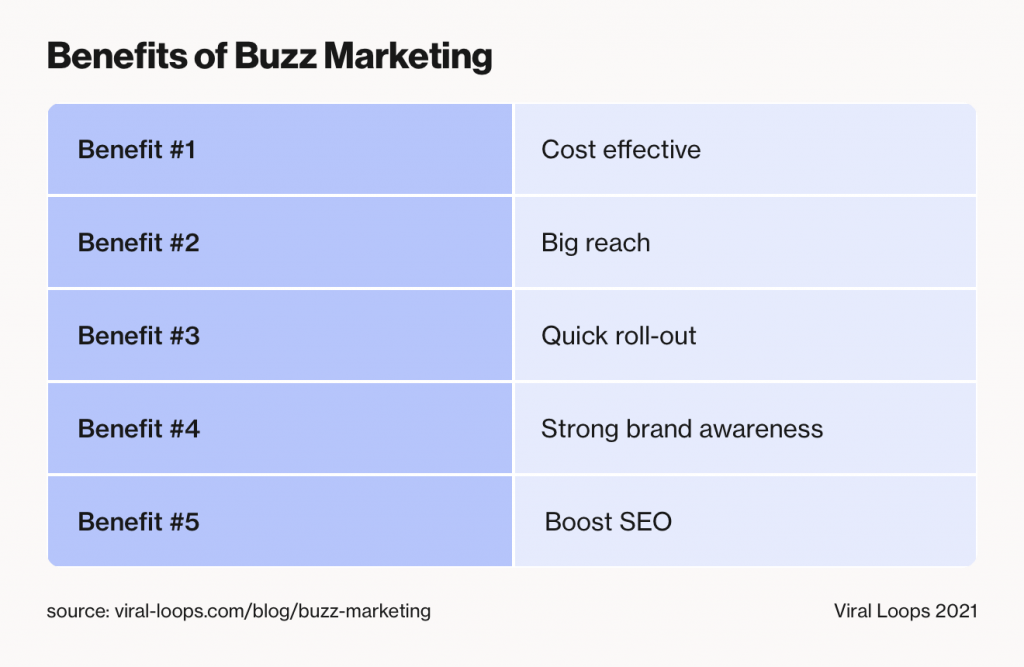
Benefit #1: Cost effective
Buzz marketing is one of the most cost-effective marketing techniques – when you get it right.
There may be some investment upfront, such as creating a video, adapting a meme to your needs, or putting together a giveaway or promotion.
Once your work starts to generate buzz, you don’t need to spend much more cash – although you’ll need to invest time in nurturing the buzz like replying to comments and questions on social media.
All in, it’s definitely a budget-friendly option to get people to notice your brand or product.
Benefit #2: Big reach
Because your customers are telling their friends and creating a buzz, you get your brand name heard by more people.
You can connect with people who don’t yet follow your brand on social platforms or who you would otherwise struggle to reach.
For example, using TikTok can help you reach an audience far outside of your area or country.
Kaja Beauty, a Korea-based beauty brand, only launched in September 2018 and has used a solid TikTok campaign to reach global audiences.

Image Source: TikTok
As you can see, they’ve earned 1.7 million viewers since they posted their first video back in November 2019 and their video can get thousands, sometimes more than 1 million views.
There’s also potential to find new markets – you may not realize that a demographic would be interested in your product.
Benefit #3: Quick roll-out
Getting a buzz marketing campaign launched should be very fast.
Especially when you’re using the internet to get your buzz going, you should quickly see your assets getting shared, your company getting tagged, and people posting with your hashtag.
Platforms like TikTok and Instagram’s Reels have made it super fast to get your message to your market, with videos from brands picking up thousands of likes in a matter of hours.
Benefit #4: Strong brand awareness
Audiences pay attention to what other people tell them more than what they see in adverts.
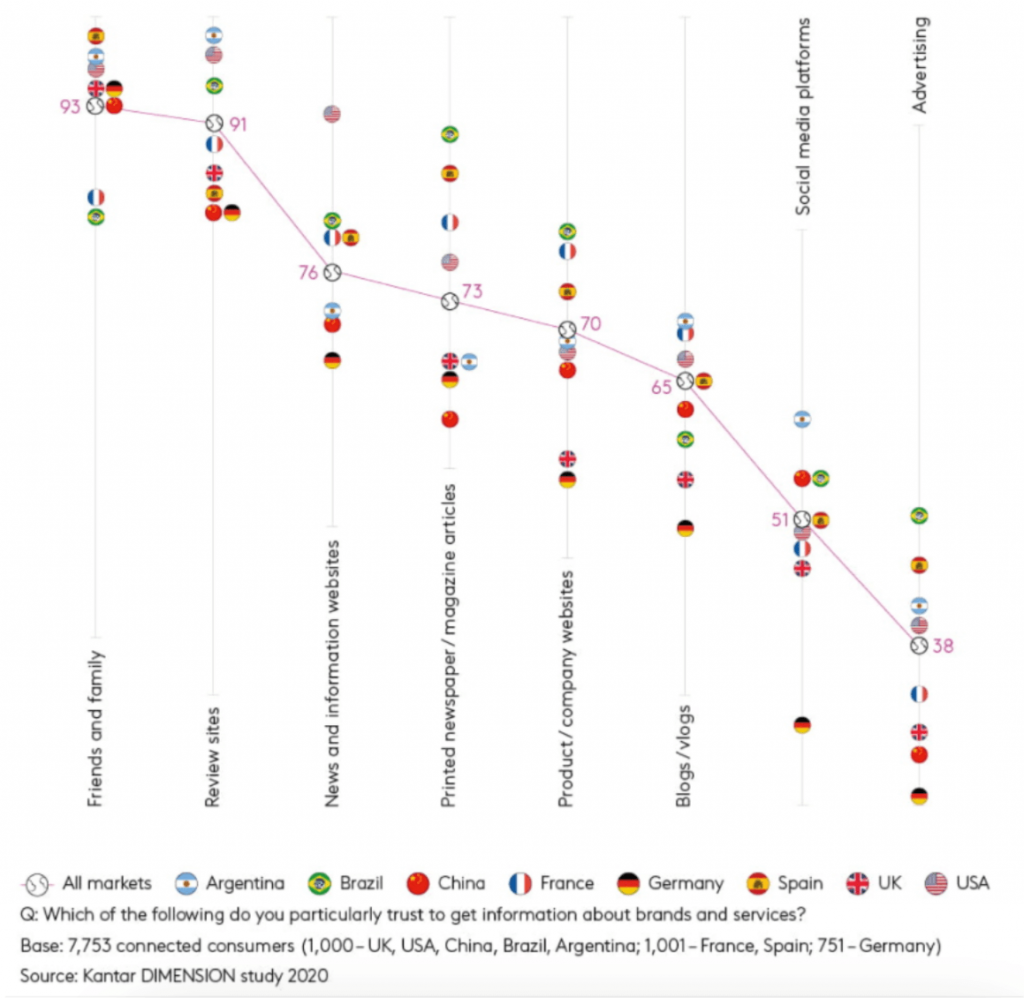
Image Source: Kantar
As you can see in the graph above, Kantar gives friends and family a trust score of 93 when it comes to product recommendations.
Interestingly, review sites come second; getting your product featured on review sites can be easier when you generate buzz because bloggers in your industry want to talk about you.
This relates to the Baader-Meinhof phenomenon, too.
This means when a potential customer sees a social media post about your business shared by a friend, they’re more likely to notice when they see your name in a shop, in an advert, on a blog, and so on.
Benefit #5: Boost SEO
Effectively generating buzz can also be beneficial to your search engine optimization (SEO).
That’s because, as we just noted, when people are talking about your brand, bloggers and influencers in your niche will start talking about you.
You can build anticipation for a product launch by sending a press release to your local media that complements your social media strategy.
It’s also possible to contact bloggers and YouTubers ahead of time and offer early access to your product for a review, unboxing, or teardown which should naturally generate backlinks for your product launch, too.
The main aim of buzz marketing shouldn’t be SEO, but it can be a positive side-effect of generating positive buzz around your product.
That’s some of the most important reasons why you should be doing buzz marketing, let’s see the different forms it can take.
What are the Types of Buzz Marketing?
Buzz marketing works by getting people to talk about your company or product.
How exactly can you make that happen?
It’s difficult to make a campaign “go viral”, but you can definitely generate buzz and excitement about what your company is launching.
Let’s look at the different types of buzz campaigns you can use to launch your product.
Type #1: Referral marketing
Referral programs allow you to offer incentives to your customers and potential customers when they invite their friends and family to your product launch.
This type of strategy taps into the trust consumers place in recommendations from friends that we looked at a moment ago.
You can offer different types of referral programs:
- A one-sided incentive, where only the referrer gets rewarded
- A two-sided incentive, where the referrer and the referred person both get a reward
By giving something in return for making a recommendation, you’re much more likely to get people talking about you.
To get people excited about your new product launch and talking about it with their friends, you can run a pre-launch waiting list with referral incentives, as Greenwood digital bank did.
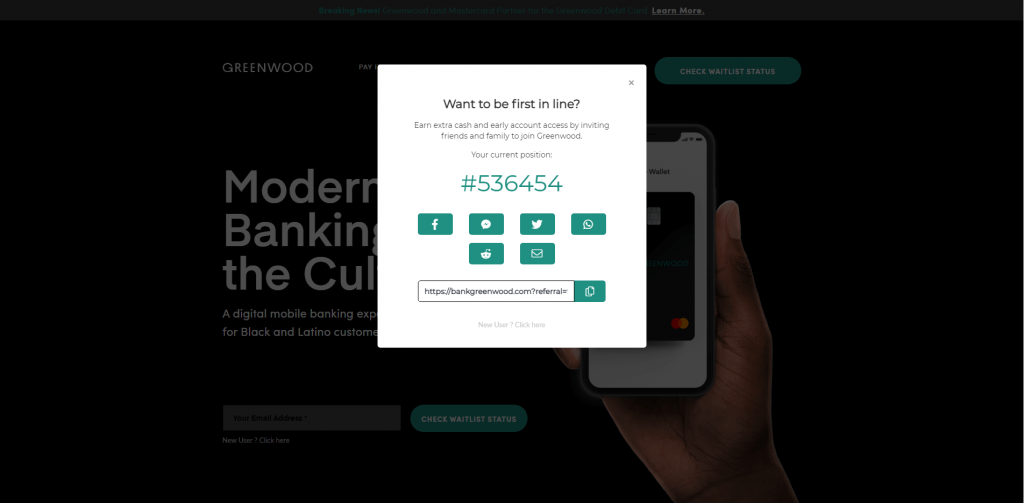
As part of the campaign, those who joined the waiting list could refer friends and jump the queue plus get financial rewards.
There were hundreds of thousands of people waiting to join up – you’d imagine there would have been a lot of people talking about the new bank at the time.
For more useful info, make sure to check out our Youtube video on Referral Rewards!👇
Type #2: Influencer marketing
Working with an influencer to talk about your product to their audience is a surefire way to get their fans talking about your product.
Finding micro-influencers who connect with your audience can help get your message out there and create excitement for your launch.
Getting your product into the hands of people with a big social media following lets their audience know that it’s trusted; the fact that it’s someone they choose to follow on social media using your product should deeply resonate with them.
In fact, a recent study suggested that using Instagram celebrities rather than “normal” celebrities will make your brand:
- Be more trusted
- Have more positive sentiment
- Get a stronger social presence
- Invoke more envy, or FOMO
All of which should increase shares and general chatter with your brand at the center.
Type #3: Online campaign
With the world’s focus on all things digital, online marketing has become the home of buzz marketing.
Creating an online campaign can mean a mix between:
- Paid advertising
- Organic posting on social media
- Blogs and articles
So that your brand and product are visible to as much of your audience as possible when they spend time online.
By the end of 2020, people were spending just short of seven hours online every day, with the most common media consumed being social media, the news, and streaming sites.
This is where most people are spending their time and having conversations, so it’s the ideal place to start to generate buzz.
If everywhere someone looks, they see your brand’s hashtag or people posting about your new product, this will generate FOMO and encourage them to seek out your brand.
In 2019, pizza delivery company DiGiorno harnessed the power of online buzz, offering a free pizza to selected people who retweeted its hashtag and their city name.

Image Source: Twitter
The promotional video received over 400k views and over 8.5 million people saw the hashtag in their Twitter feeds.
An online campaign is a great way to reach a wide audience spread across a large geographic range.
Type #4: Event sponsorship
Sponsoring an event is a useful way to get your name associated with another successful brand.
You can work with any event that matches what your product launch is all about and that your audience will usually engage with.
Sponsorship can be open to any type of event, including:
- A local town or school fair
- A state-wide sporting event
- An industry trade show
- A national festival or concert
- A global online conference
Once your name is on the website and other advertising materials, more people will be curious about your company and you can even have the event include your name in the brand.
Tech company Intel has sponsored Intel Extreme Masters, an esports tournament, since 2006.
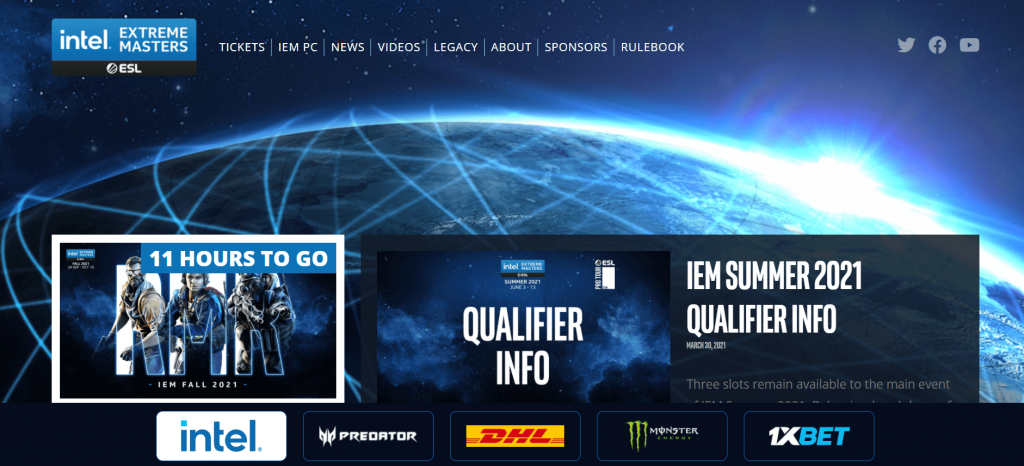
Image Source: Intel Extreme Masters
The partnership works well; gaming fits in with the computer processors Intel sells and having their name in the title means everyone who follows this competition will know exactly what the company is all about.
Type #5: Spread a rumor
Gossip is a primal urge for most people – we like to be in on a secret and know what’s going on in the world around us.
Your brand can tap into this human trait by starting a positive rumor about your brand.
Big companies can generate buzz by releasing snippets of information to the press about a new product before the launch date.
Having the cast of a movie give away little details of a movie is a classic technique to generate buzz – Tom Holland giving away secrets about The Avengers movies is a recent example.
On a small scale, in the weeks running up to your product launch, you can offer a teaser to your followers on social media platforms and even ask them to guess what your new product is.
L’Occitane, a global skincare brand used this tactic in April 2021, as you can see below.

Image Source: Instagram
By telling its target market there was something new coming, but not giving away details, it gets them talking and discussing it with each other.
This technique is adaptable to nearly all products when you have an engaged audience.
Now we’ve seen the types of buzz marketing campaigns you can launch, let’s check out some companies working this marketing method.
5 Examples of Buzz Marketing to Inspire You
There’s nothing like strong examples of buzz marketing campaigns to get your creative juices flowing, whether you’re in content marketing or are a marketing agency.
Some brands really know what they’re doing when it comes to using the right strategies to get attention and generate FOMO.
Example #1: Wise (formerly Transferwise) and referral marketing
Wise, formerly Transferwise, is an online money transfer service that really knows how to create a buzz with its marketing efforts.
When the company launched, the team behind it put a lot of work into getting the brand name out there, with the VP of Growth Nilan Peiris saying, “We realized [sign-up bonuses] only worked when the person who was hustling on our behalf was an existing customer.”
Along with making controversial ads to create buzz, like the one below, the company launched a referral program.

Image Source: Medium
The referral program has changed over time and currently offers a free international transfer of up to $500 for the referred person and a $75 bonus for the referrer once three friends transfer at least $300 each.

Image Source: Money’s My Life
It definitely creates a buzz and has people talking about the company, particularly in places on social media where expats gather.
In the two screenshots below, you can see the level of advocacy and buzz that Transferwise has around its product.
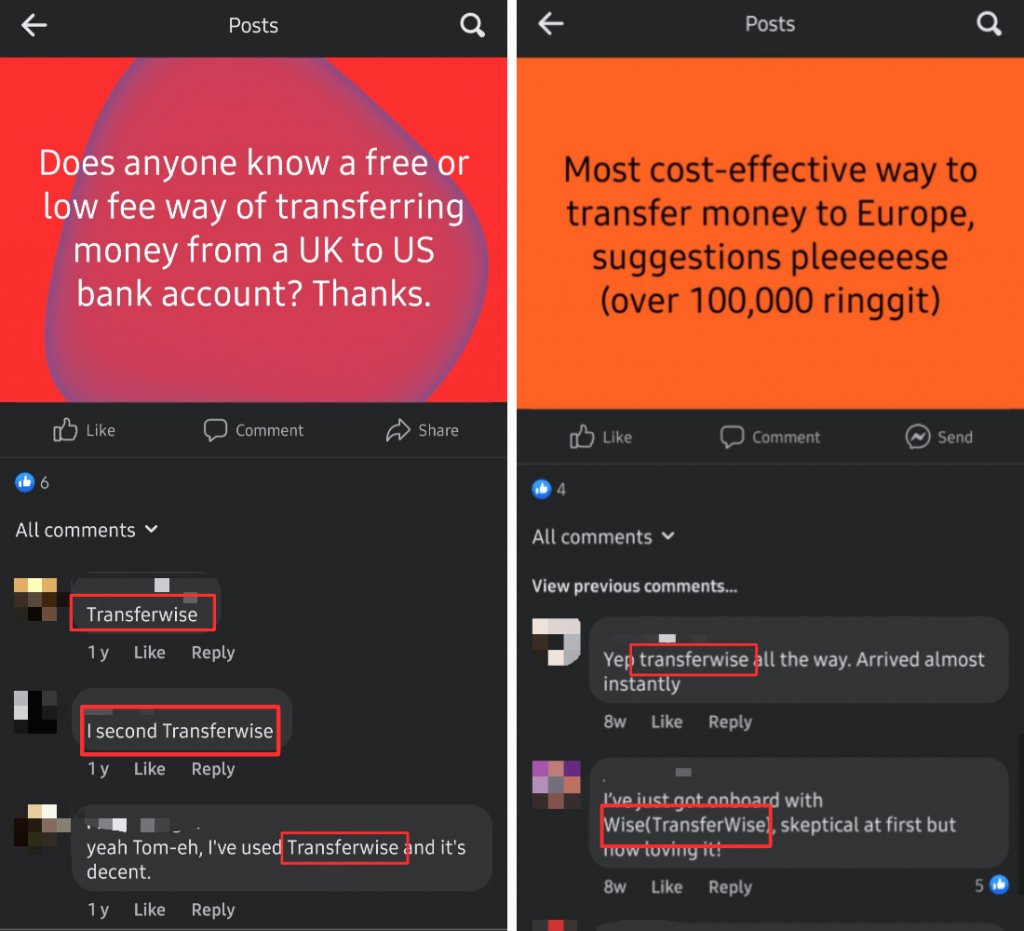
Image Source: Facebook
By creating a valuable product and encouraging people to share it with their friends, Wise has established a strong base of brand ambassadors who will happily chat and share their experiences.
Example #2: The Super Bowl and event sponsorship
Almost as important as the Super Bowl itself is the advertising that gets shown.
It’s a great example of event sponsorship and the weeks leading up to and just after the Super Bowl each year generate lots of buzz and conversation.
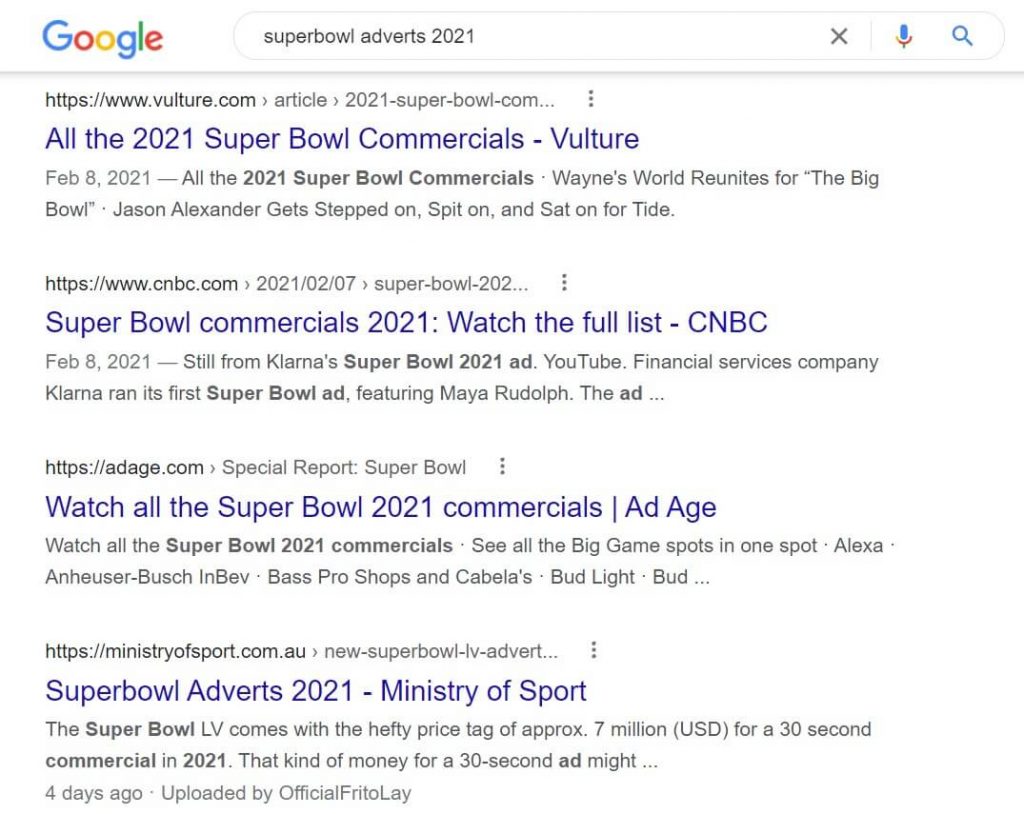
Image Source: Google
As well as the news sites and blogs talking about Superbowl adverts, the public gets in on the act, too.
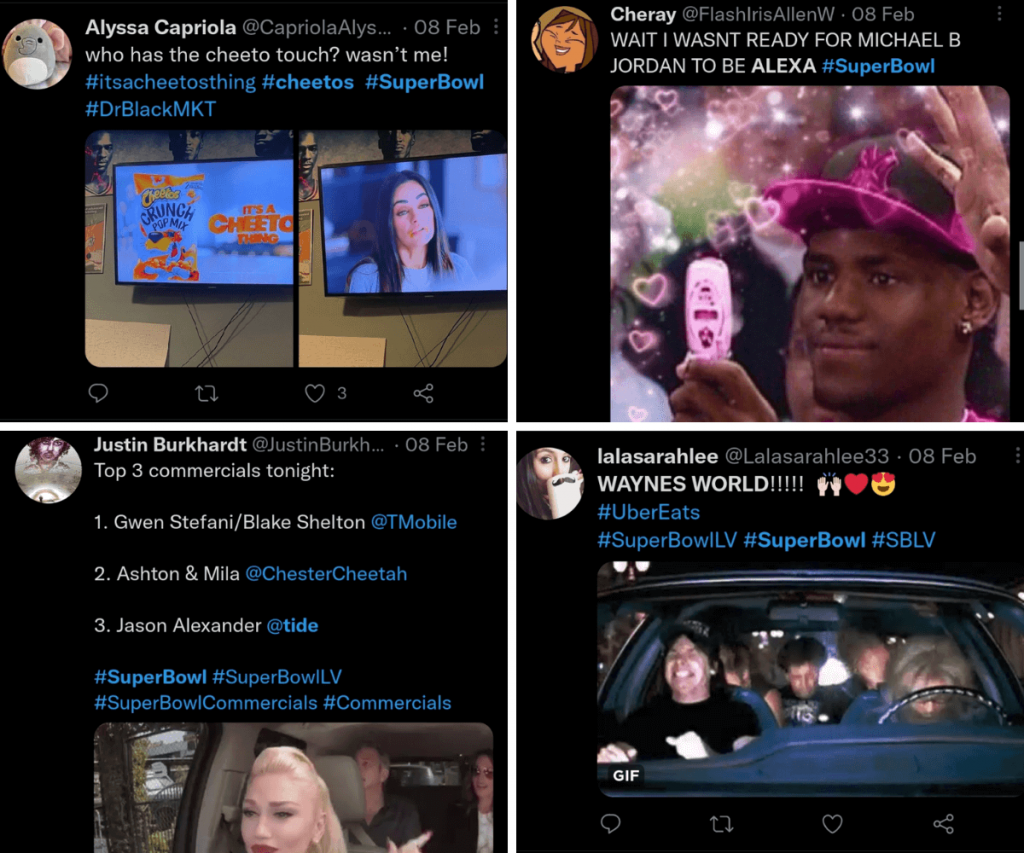
Image Source: Twitter
Thousands of people on social media sites like Twitter talk about the advertisements around the Super Bowl, generating buzz for weeks before and after the sporting event.
What’s more, the half-time show has become an event itself and has been sponsored by Pepsi since 2011.
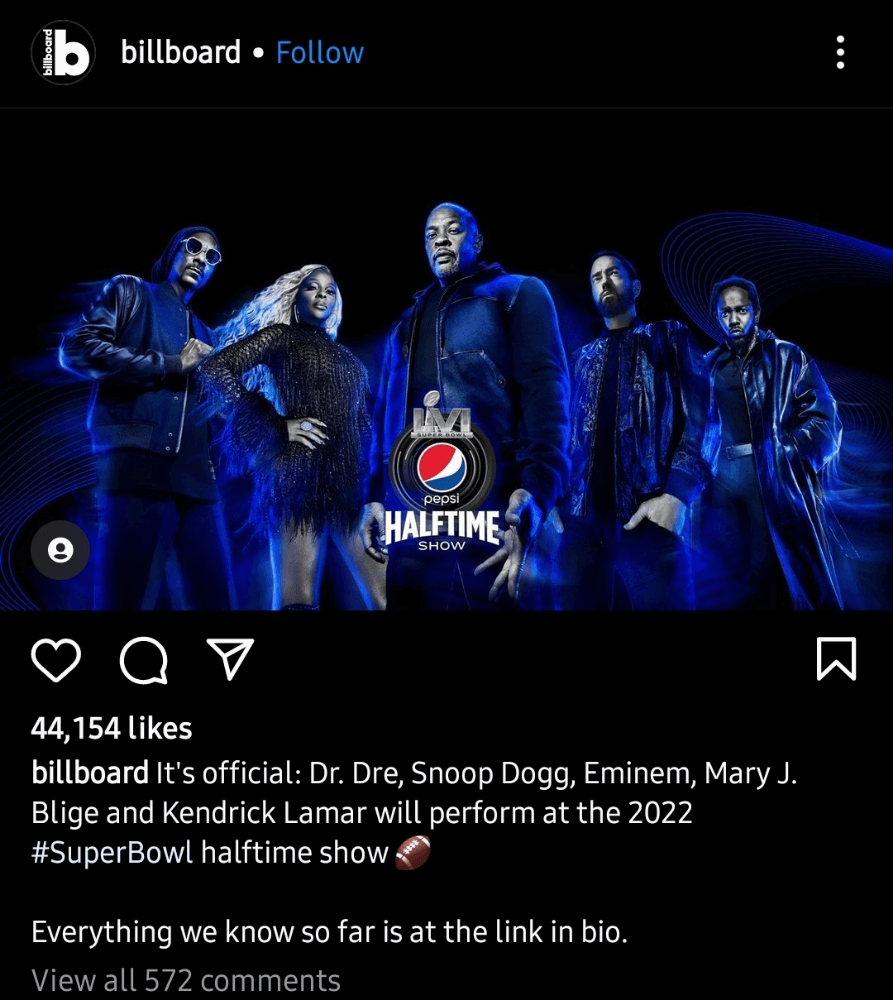
Image Source: Instagram
Talk about the event starts months before – Super Bowl is in February and this news was released in the previous September!
While small business owners may not have the budget to take out an ad during the Super Bowl, you can still take inspiration from how buzz is generated.
There is lots of hype and build-up to the event, the marketing efforts get picked up by the media and audiences because of the humor and innovation, and conversations start months before the event to keep the buzz going all year.
Example #3: Puma and influencer marketing
The famous sports brand Puma has a successful influencer marketing campaign that generates buzz across the fan bases of the people it collaborates with.
Along with partnerships with famous sports stars, such as Brazilian soccer star Neymar Jr…
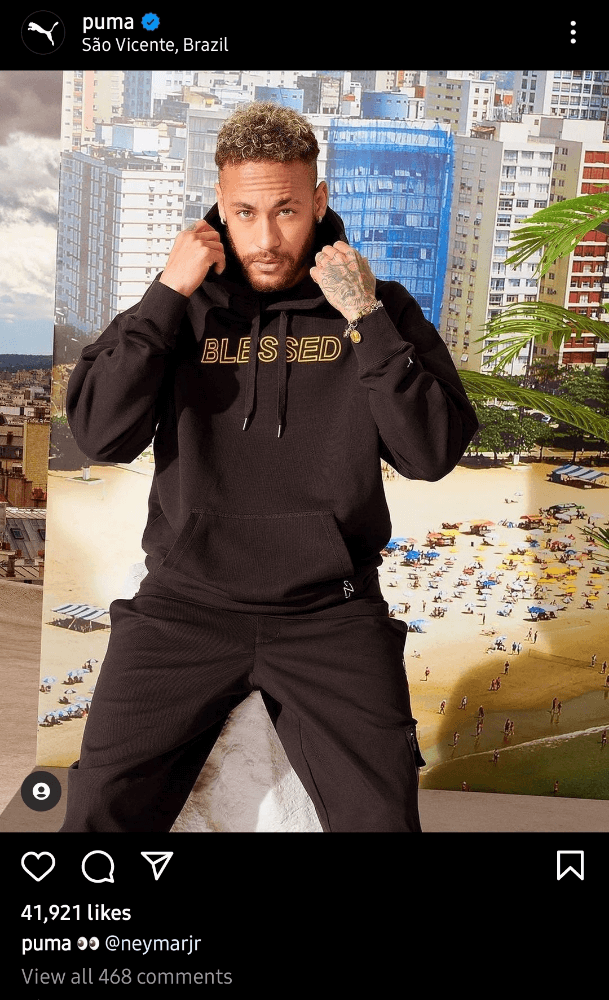
Image Source: Instagram
… and Olympian Molly Seidel…
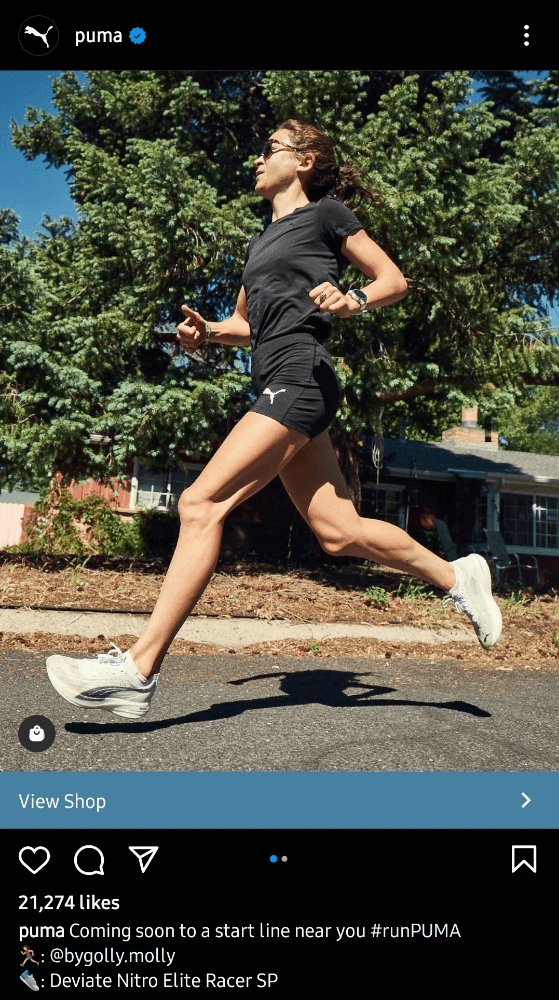
Image Source: Instagram
… Puma also works with musicians like Dua Lipa.
Dua Lipa has over 73 million followers on Instagram and is known in fashion circles as well as for her music, working with labels like Versace.
As well as posting on the Puma Insta feed:
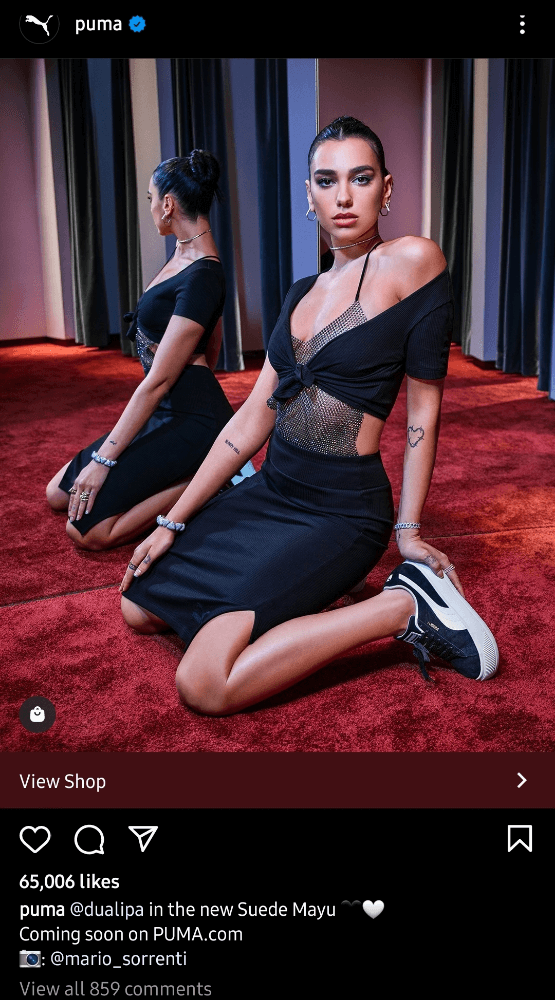
Image Source: Instagram
Images from the same photoshoot were shared with Dua’s fans on her own Insta account:
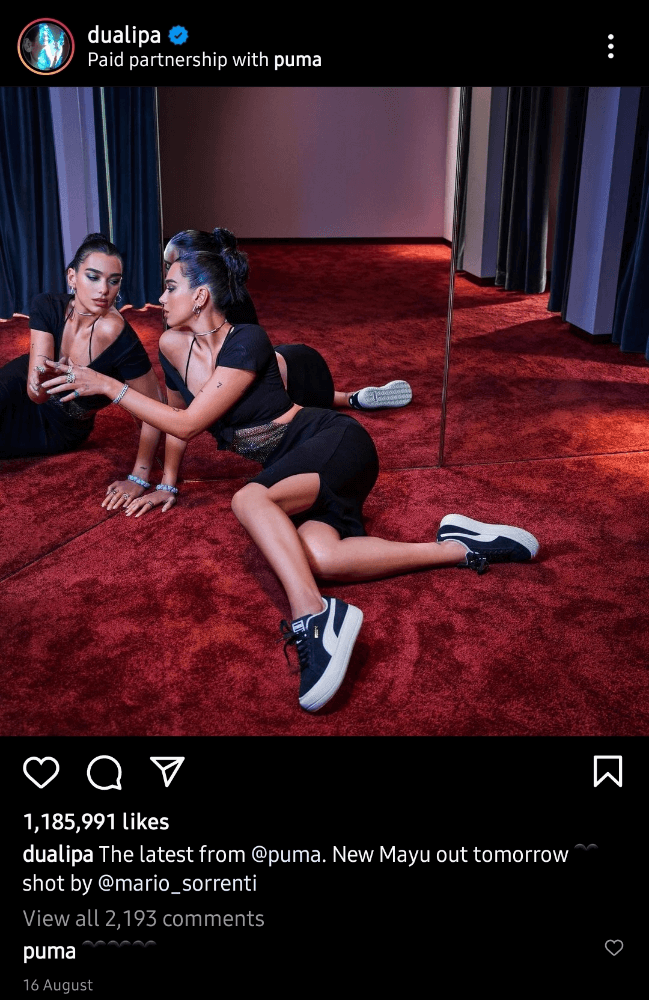
Image Source: Instagram
By working with a star such as Dua Lipa, Puma is able to reach a new audience and increase the number of people who will be talking about and sharing images of their products.
As you can see by the engagement levels on these posts, they’ve definitely created a buzz across two audiences that are likely from different demographics.
Example #4: Apple and spreading rumors
The launch of a new Apple product is always hotly anticipated and the company supports the hype by releasing rumors about any new product’s features.
In fact, Apple is so famed for its rumors, there are whole websites dedicated to tracking the information that gets leaked prior to launches, such as 9to5Mac and MacRumors.
Running up to the launch of the iPhone 13 in the middle of September 2021, sites like these were buzzing with rumors about everything from potential names to colors for the new phones and how much storage space would be available.
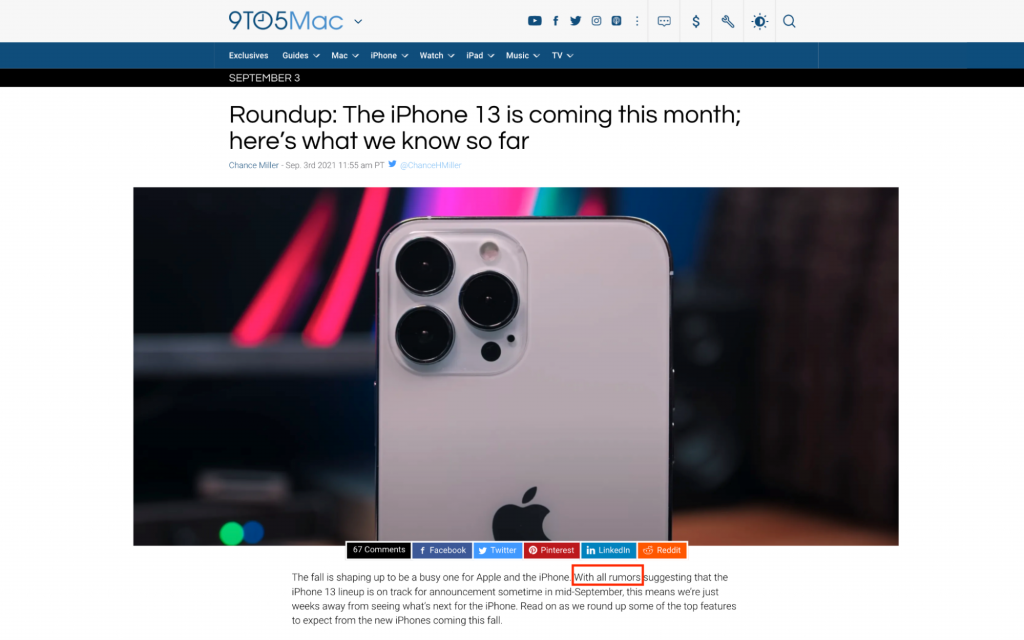
Image Source: 9to5Mac
Indeed, Apple fans are so aware of the rumors about product launches, “iphone rumors” is a common search term that spikes when new products are imminent:
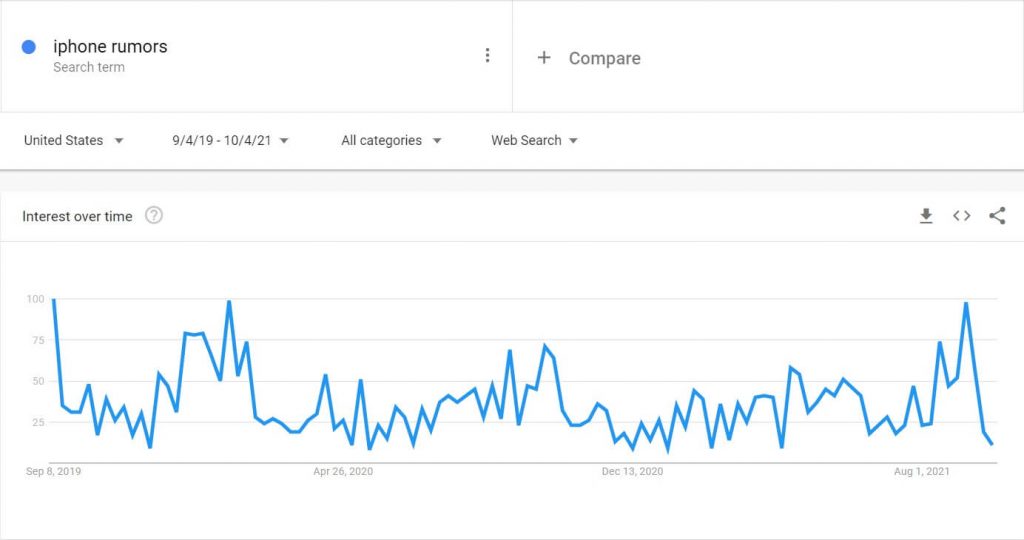
Image Source: Google Trends
Having so much hype surrounding new iPhones generates strong FOMO; people see everyone talking about the new product and want to be part of the conversation and have the product first among their peer group.
Whether you choose to leak details about your product or upcoming launch to bloggers and local media or using your social media accounts like L’Occitane, it’s an effective way to start conversations with your audience.
Example #5: Ghetto Golf and using local media
An off-the-wall miniature golf course in Liverpool, UK, called Ghetto Golf has a venue that generates buzz just from being so different and entertaining.
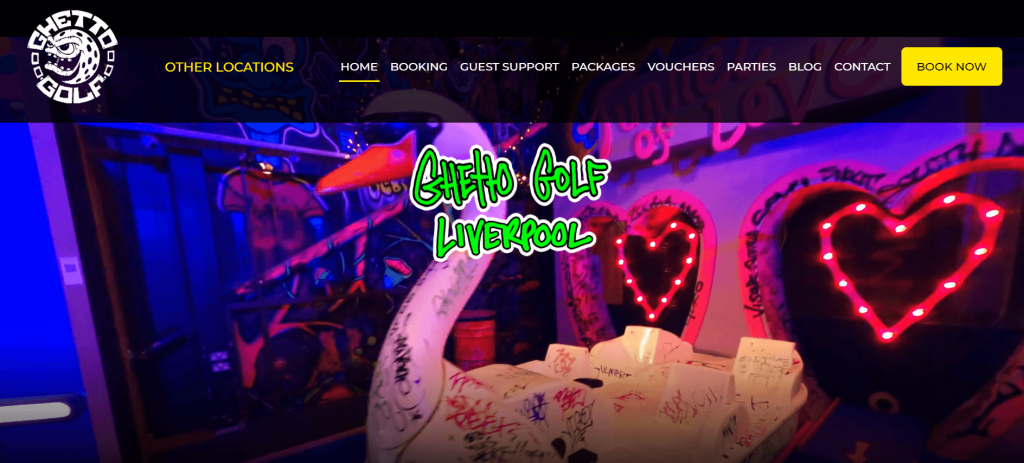
Image Source: Ghetto Golf Liverpool
User-generated content (UGC) and word-of-mouth marketing strategies are used by the brand to make sure people keep talking about them.
To add to their brand visibility, sometimes the company also starts rumors…

Image Source: Facebook
Which then get picked up by the local media:

Image Source: Liverpool Echo
Working with local media to get coverage of stories – whether the truth or something close to it – is a great way to generate a local buzz and have people share your content and brand name.
Let’s round this out with some tips for your buzz marketing campaigns.
3 Buzz Marketing Tips You Need to Know
Now you’ve seen what buzz marketing looks like, it’s helpful to know some ways to go about it.
We’ve put these together based on our experience working with brands to create a buzz with their referral marketing and pre-launch campaigns.
Tip #1: Talk to your target audience
Knowing your audience is key to starting conversations with them.
Depending on your product, your target audience may use LinkedIn, Facebook, Reddit, or one of the other social media platforms.
There will be other media to consider, such as bloggers in your niche and YouTube channels who speak to your target demographics.
To start creating a buzz, you need to find the people who want to talk about your products.
Tip #2: Focus on what makes you different
People will talk about something new and innovative or that solves a problem they and their friends experience.
Of course, your product is special and unique to the market so highlighting these elements will be a way to generate buzz.
Generate buzz about why only your new product can fix pain points, without being negative about your competitors.
The bottom line is; be different and people will engage with your brand.
Tip #3: Harness all your channels
You have lots of different channels open to you for creating a buzz so you should use them all in a coordinated way.
Use your owned media like your website, blogs, and social media channels to start to get your message across.
By networking with local and online media, you can also earn media attention which should continue your buzz marketing.
You can also pay for ads on social media and other channels to support your campaign and help people move down your sales funnel once they’re interested in the buzz you’re creating.
Reach out to your audience in every way possible so they can’t help but see your message.
How to Create a Buzz Marketing Campaign
Are you inspired by our buzz marketing examples and tips?
You can create your own buzz marketing campaign by following our four-step plan.
Step #1: Set a goal
As with any marketing campaign, you need to set a goal.
This will depend on your business and what you’re looking to achieve; examples of goals for a buzz marketing campaign include:
- Increasing the number of people who refer a friend to your business
- Uplifting your social media engagement numbers
- Upping your brand recognition across your target audience
- Generating more leads for your business
Make sure that your goal is measurable and achievable but also a challenge to work towards.
Step #2: Plan your campaign
Next, you need to choose how you’re going to generate your buzz – our list of different types of campaigns can help you decide how you’re going to run your campaign.
You’ll need to find a company to help run your referrals and get a buzz started or choose the influencers you want to work with.
Here at Viral Loops, in a very shameless plug, we want to recommend our efficient tools for your Referral Marketing efforts. And also announce that we’ve just added our best feature yet!
With Viral Loops Rewards, your account is now fully equipped to connect and send actual rewards. Through integrations with Stripe and Tremendous, sending out gifts is now a seamless process. This makes the process for creating your next referral campaign a breeze!
Then, you need to coordinate your channels, with social media posts tailored to the different platforms you use and press releases and blog posts on your website.
Whichever type of buzz marketing campaign you want to do, have a strong plan that’s feasible to execute.
Step #3: Launch your campaign
Launching your campaign is the exciting part!
You can start to run your social posts, send out your emails to your list of contacts, and begin to see your brand and new product get talked about.
Have people ready to respond to comments and reply to emails – you want to keep the buzz going and the more public comments you respond to, the more likely your posts will appear in other people’s feeds.
Step #4: Monitor the results
To ensure that your buzz marketing campaign is a success, you need to follow up on the results.
You’ll have defined what success looks like in the first step; now is the time to see if you hit or exceeded your targets.
Be sure to create reports that tell you about the positive outcomes and share them with your team and C-suite.
When you know your campaign was a success, you’ll be in an even better place to launch your next buzz marketing campaign.
That’s how you do it, now let’s wrap this up.
Before You Go
You should have a really solid grounding in what buzz marketing is, what it looks like, and how to create a successful buzz marketing campaign.
It’s a tool that’s commonly deployed by large and small brands and can work really well to get your name out into the market and on the lips of your audience.
Want to get your referral campaign ready to start generating buzz?
Book a demo with us and we’ll show you how simple it is to get your buzz started.
